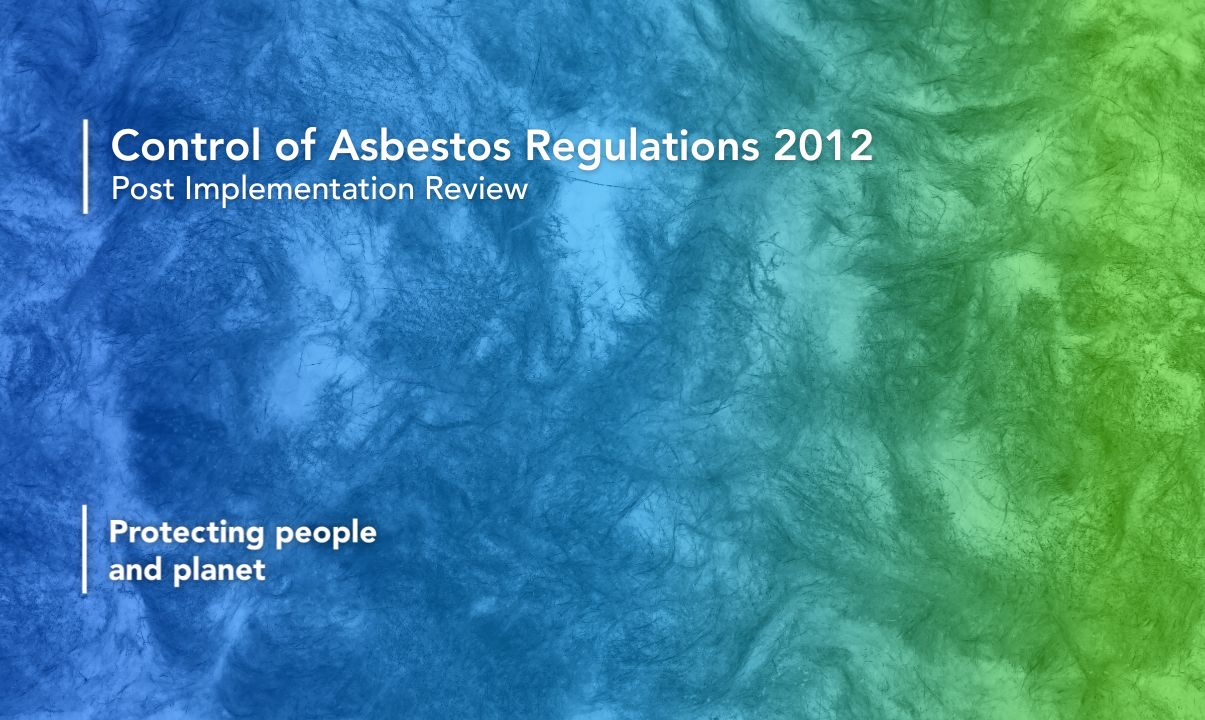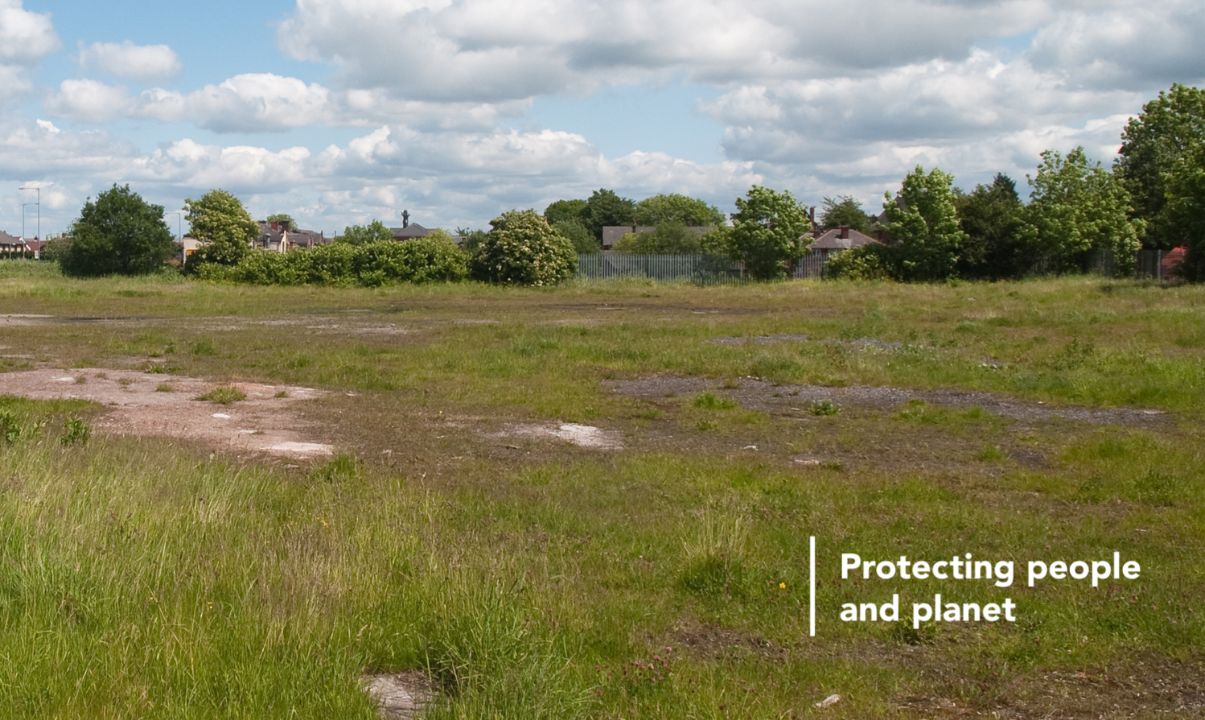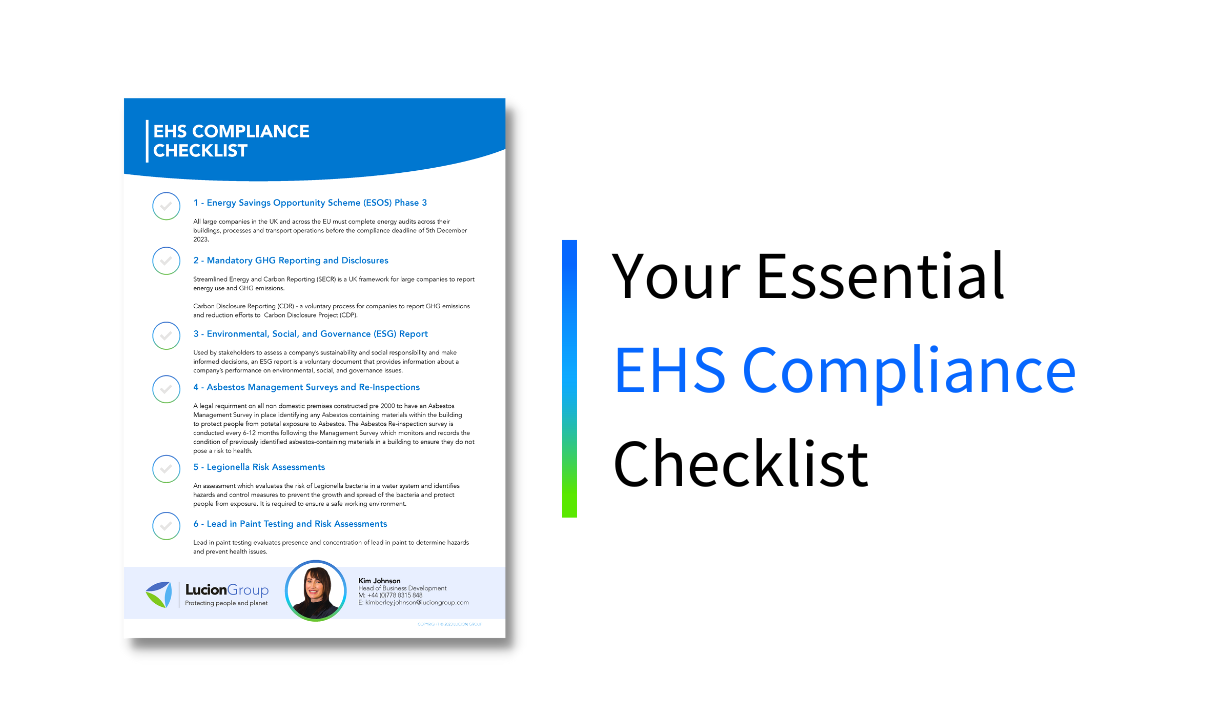What Does The Post Implementation Review of the Control of Asbestos Regulations 2012 (S.I. 2012/632) Mean For The Asbestos Industry?
5 April 2023
After delays to publication due to consideration of the Work and Pensions Committee (WPC) report published in late April 2022, 'The Health and Safety Executive's Approach to Asbestos Management', the HSE published their Post Implementation Review (PIR) of the Control of Asbestos Regulations 2012 (S.I. 2012/632).
Lucion Group’s Assurance Director Chris Parr provides insight into the PIR Report and what it means for the industry.
What Are The Objectives Of The Post-Implementation Review of the CAR 2012
Originally due to be published in early April 2022, the PIR was developed with the objectives to assess the effectiveness of the current regulation, whether the current regulations and objectives are still relevant, and assessing the current financial impact of the current and updated regulations on businesses and deliver guidance and advice on implementation.
The Current Asbestos Regulations
There are strict HSE and legal duties placed on people (‘Duty Holders’) in charge of public buildings aimed at reducing the risks to health that asbestos-containing materials (ACMs) pose, and there should no longer be any excuse for anyone being exposed to potentially dangerous levels of airborne asbestos fibres in any building.
2022 marked the 20th anniversary of the Asbestos Duty to Manage introduction (2002 marked the beginning of the implementation period which was completed in 2004). Since this key regulation came in, multiple industry bodies and professionals have campaigned for the HSE to review these regulations with the intent to align the current clearance level indicator to that close to our European counterparts, including the latest Parliamentary Inquiry into HSE's approach to asbestos management which began at the end of 2021 and was published in 2022 with several recommendations including;
- Using recommendations from the enquiry to inform the Post Implementation Review and develop research - Accepted
- HSE’s asbestos-related research - developing new methods of information capture to determine duty holder compliance and inspection programmes - Accepted
- Central Register of Asbestos in non-domestic Buildings - Rejected
- New exposure levels - HSE to review the evidence and requirements for new workplace limits - Accepted
- Information sharing - educating duty holders to manage the risk and reduce worker exposures - Accepted
- Regulatory activity - HSE focus to commit to a programme of inspections - Accepted
- Using outcomes from duty to manage inspections to inform future activities - Accepted
- Communications and increased campaigns targeting the risk from work with asbestos as part of the UK’s net zero agenda - Accepted
- Notifiable and non-notifiable work - HSE will explore further the categories of work within the regulations - Accepted
- Use of Asbestos surveyors - HSE to engage with UKAS and stakeholders to further reinforce guidance - Accepted
- Asbestos strategy - a fixed deadline of 40 years for removal of all asbestos was seen as a concern - Rejected
- Occupation recorded on death certificates could introduce bias and would require buy-in from many Government Departments - Rejected
The HSE’s PIR, released in January 2023, reviewed the effectiveness of the current regulations, CAR2012, comparatively to our EU counterparts. The PIR claims that the UK, compared to EU member states who have implemented the same asbestos directives, now consolidated as 2009/148/EC, is largely on par with the rest of the EU and in some instances operates a more robust system for annual inspections. Where the UK has fallen behind, the PIR admits, is on asbestos air testing and monitoring;
“We recognise the limitations and difficulties of representative air sampling at very low concentrations, and we do not require such air monitoring. Air monitoring relies on effective sampling as much as the technicality of measurement because asbestos does not remain airborne. In very low concentrations there is a greater risk of results that cause the wrong decisions to be made in managing asbestos. Whereas visual inspection can identify asbestos that requires action irrespective of an air measurement result.”
- 91. Second Post Implementation Review of the Control of Asbestos Regulations 2012 S.I. 2012/632.
The Historic Issue of Asbestos
During the periods of 1920 – 1970 and 1971-2000, Europe used 48% and 58% of the entire world’s trade of asbestos, arguably making Europe the historical global centre of asbestos use; the UK, Germany and France being the highest importers.
In the UK during the 1950s, 60s and 70s there was a ‘building boom’, in which amosite asbestos was used inside buildings as insulation/insulative products and chrysotile asbestos was used in the cement and cladding on the outside of buildings.
Since the ban of asbestos in the UK in 1999 and extensive research conducted into the harmful effects of asbestos, it has long been recognised that the disturbance of Asbestos Containing Materials (ACMs) in older buildings can lead to harmful fibres being released, with dangerous health risks to individuals.
Airborne asbestos fibres that are small enough to reach the deep lung tissue have no way of being pushed out via breathing so the body has to use other methods to get rid of them.
The main method is to try and dissolve the foreign body with acids, however, some asbestos is resistant to acid. As a result, the acid damages the tissues surrounding the asbestos fibres. This causes scar tissue and other medical effects known as asbestos-related diseases.
The current acceptable level of airborne asbestos fibres (HSE clearance indicator) used to declare the area(s) of a building safe for normal occupation following licensed asbestos removal, is less than 0.01 f/ml. The HSE defines licensable work concerning Control Limits whereby risk assessment cannot clearly demonstrate that airborne fibre levels will not exceed 0.1f/ml averaged over a 4-hour period or 0.6f/ml averaged over a 10-minute period. Many European countries and closest neighbours introduced far stricter controls. For example, the Netherlands updated its occupational exposure limits to 0.002 f/ml in 2014 intending to lower it even further to 0.0003 f/ml in the future. Whilst there is ample evidence suggesting that the current HSE clearance indicator used is inadequate, it has remained the same for the past 30 years.
Despite the import, supply and use of asbestos being banned since 1999 in the UK, 5,000 premature deaths per year are related to asbestos and asbestos-related diseases. Asbestos accounts for more deaths per year than road traffic accidents. The UK death rate for asbestos-related diseases continues to be the highest in the world. Aware of these facts, the UK Health and Safety Executive (HSE) has been accused of failing to put in place the measures required to adequately combat our asbestos legacy issues and adequately protect members of the public from harm, especially in relation to the current clearance indicator levels.
Are The Current Asbestos Regulations Effective?
Concerningly, the outcome of this latest PIR from the HSE concludes that the current asbestos regulations are achieving their intended objectives and that it is not necessary to amend the provisions of CAR 2012 at this time.
“The majority (71.1%) of respondents believed that the CAR 2012 regulations are effective in protecting workers from the risks of asbestos and its objectives could not be achieved with a system that involved less regulation. As outlined in Appendix 1, 65.8% of participants agreed that the guidance which HSE provided on the application of the new CAR 2012 requirements mitigated the impact of the legislative change on businesses.”
- 36. Second Post Implementation Review of the Control of Asbestos Regulations 2012 S.I. 2012/632.
After reviewing the WPC recommendations, the HSE has determined that:
- the regulations are successfully fulfilling their intended objectives and that those objectives are still relevant,
- regulatory intervention is still necessary and continues to be the most efficient approach to managing the risks associated with asbestos exposure,
- there is no need to modify the provisions of CAR 2012 presently.
One of the reasons the HSE may continue to resist the review of the current clearance indicator and wider regulations could be due to the cost implications associated with more stringent controls.
What Are The Costs Implications For Managing Asbestos?
The updated estimate for the total annual compliance cost under the current CAR 2012 is approximately £741m (low estimate is £493m and a high estimate of £1,096m). In a best-case scenario, the PIR states an estimated annual cost increase of £236m since the 2017 PIR estimate (£254m), taking the total estimate to near £490m in 2022.
Figure 13: Summary of indicative total annual cost differences from 2017 PIR Regulation category (Source: https://www.legislation.gov.uk/uksi/2012/632/pdfs/uksiod_20120632_en.pdf page 149):
|
Regulation Category |
Cost Item |
Total annual costs difference 2017 and 2022 (best estimate, £m) |
|---|---|---|
|
Non-Notifiable work |
Refresher training |
£16.2 |
|
Non-Notifiable work |
Cost per risk assessment |
£15.5 |
|
Non-Notifiable work |
New entrants training - task specific, full day course |
£65.7 |
|
Non-Notifiable work |
New entrants training awareness course |
£10.3 |
|
Non-Notifiable work |
PPE costs |
£37.7 |
|
Duty to manage |
Schools |
£10.0 |
|
Duty to manage |
Large companies managing asbestos |
£28.4 |
|
Duty to manage |
Medium-sized companies managing asbestos |
£33.4 |
|
Duty to manage |
Micro companies managing asbestos |
£26.2 |
|
Licensed and NNLW |
Assessment of work which exposes employees to asbestos |
£1.9 |
|
GDP deflator uplift to licensed & NNLW |
Regulations: 5, 8, 9, 10, 11, 12, 14, 16 & 17 & 23, 21, and 22. GDP deflator uplift. |
£5.4 |
|
Total annual cost of significant differences |
Significant differences |
251* |
|
Total annual costs |
All difference |
£254** |
*Figure may not sum to above table due rounding.
**Figures may not sum to above table as there as additional cost lines have not been included
Whilst the position of the HSE is to continue with its current guidelines and no adjustments to air quality requirements or clearance indication adjustment, organisations can play a crucial role in mitigating risks to people and the environment.
There are currently an estimated 300,000 non-domestic buildings containing asbestos in the UK. Operating a beyond-best-practice schedule when managing asbestos hazards is core for many businesses looking to implement Environmental, Social, Governance (ESG) and sustainability measures to progress towards the United Nations Sustainable Development Goals (SDGs).
Asbestos and ESG
ESG is increasingly influential in decisions regarding mergers, acquisitions, and development. Companies must disclose their ESG risks and opportunities, approach to mitigation, and financial implications to satisfy various stakeholders such as investors, customers, employees, and government companies. ESG comprises Environment, Social, and Governance factors, which respectively relate to a company's impact on the physical environment, its relationships with people, and its decision-making framework.
Asbestos, as previously described, is hazardous to human health in multiple phases of the asset lifecycle in every sector. Asbestos released into the environment during activities such as construction, demolition, mining, and manufacturing can contaminate the air, water, and soil. This can lead to inhalation of asbestos from the air, ingestion from water, and redistribution into the air due to soil disturbance.
The effective control of asbestos management and prevention of harm arguably comes under all three sections of ESG:
- E - The effects of asbestos on humans are widely known, however, what is often overlooked is the effects asbestos has on the surrounding environment and its animal inhabitants. Asbestos, when disturbed, can pollute the air, water, and soil, and settle on objects. The effects of asbestos on domestic animals and wildlife, who may reside in areas where asbestos is improperly disposed of or near construction works are largely the same as humans.
- S - The effective management of asbestos largely comes down to trust between the duty holder and their community, whether that be the general public or employees. The majority of people won’t dive into an asbestos report to find out where there may be a risk on a site where they are working or living but work based on trust that the duty holder has implemented adequate measures to ensure their safety when on their premises.
- G - As outlined by the HSE, asbestos management costs, and in some cases carries a big price tag. Ensuring asbestos and other hazardous materials risks are adequately funded is essential to compliance and business continuity. Duty holders are required to manage asbestos risks in line with the Control of Asbestos Regulation (CAR) 2012. Effectively managing asbestos risks is imperative to protecting building occupants, the environment, and organisations from the risks of asbestos.
The benefits of effectively managing asbestos aren’t limited to your ESG initiatives. It’s bigger.
ESG, SDGs and Asbestos
It is important to distinguish between ESG and Sustainable Development Goals (SDGs). The SDGs are global objectives established by the United Nations, whereas ESG is a rating system utilized by companies to assess their environmental and social performance. Incorporating sustainable development practices into daily operations and products/services enables companies to leverage ESG factors for success, which can ultimately align with the SDGs. Notably, asbestos is closely linked to the SDGs.
Under SDG goal 12, Chemicals and Waste (Hazardous), the UN States:
"Environmentally sound management of hazardous wastes" is the subject of Chapter 20 of Agenda 21. Effective control of the generation, storage, treatment, recycling and reuse, transport, recovery and disposal of hazardous wastes is, according to Agenda 21, "of paramount importance for proper health, environmental protection and natural resource management, and sustainable development." Prevention of the generation of hazardous wastes and the rehabilitation of contaminated sites are the key elements, and both require knowledge, experienced people, facilities, financial resources and technical and scientific capacities.”
Concluding Thoughts
Whilst this latest review of the Control of Asbestos Regulations comes up short, the asbestos industry can continue to make strides and push for clients to make better decisions when it comes to asbestos management. As more investors and asset owners seek to retrofit their existing buildings and assets with sustainability tools such as solar panels or heat pumps, the effect of potentially hazardous materials on people and the environment must be considered. Going above and beyond the requirements of CAR 2012 will not only increase the value of client assets but also future-proof against higher costs when retrofitting and upgrades are required.
Our companies within the Lucion Group, provide asbestos services through our inspection companies and ESG benchmarking assessments, utilising bespoke frameworks designed to progress your sustainability agenda.
If you would like to understand the frameworks that we use and want to know more about how we can help you progress your ESG and sustainability goals, and reduce your risks, contact our team today by clicking here.
About The Author
Chris Parr
Group Quality and Assurance Director
Chris has over 19 years of experience specifically monitoring, managing and leading on quality assurance for the Lucion Group, having joined us via Lucion’s acquisition of AOH Ltd in 2011. Chris was integral to the successful creation of a strong QHSE culture at Lucion Services, where he maintained an integrated Quality Management System to include ISO17020, ISO17025 (requirements for asbestos testing, and inspection accreditation by UKAS), ISO9001, ISO14001 and ISO45001 (certified by BSI).
In his role as Group Assurance Director for the Lucion Group, Chris utilises his experience gained and integrates our strong culture for integrated quality management across our Lucion Group portfolio of companies, working closely with the Lucion Group Technical Director and our business leaders.
E: chris.parr@lucionservices.com
Linkedin: Chris Parr
Asbestos Compliance: 6 Step Checklist
Download our free 6-step Asbestos Compliance Checklist and take the first step to safeguard your teams, contractors, and reputation.
No Sign-Up Required
Asbestos Management in Education Settings
Head of Business Development Kim Johnson, with 12 years of experience within the asbestos industry, outlines how education settings can manage their asbestos hazards.
No sign-up required.
IMPACT Magazine
Industry news delivered by Lucion Group and its subsidiary companies.
Issue 2 May 2023
No sign-up required


 NexGen
NexGen












